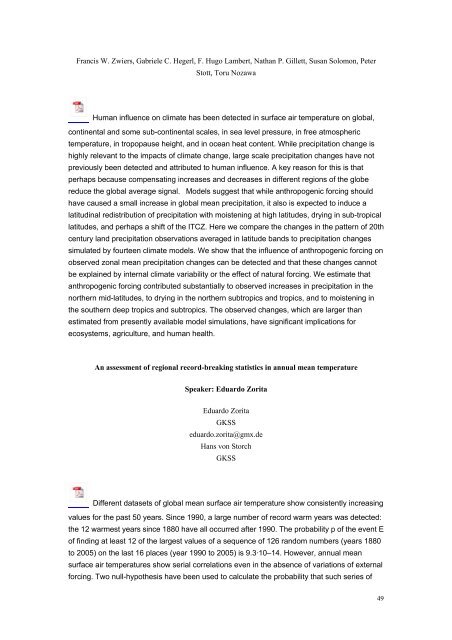The tenth IMSC, Beijing, China, 2007 - International Meetings on ...
The tenth IMSC, Beijing, China, 2007 - International Meetings on ...
The tenth IMSC, Beijing, China, 2007 - International Meetings on ...
Create successful ePaper yourself
Turn your PDF publications into a flip-book with our unique Google optimized e-Paper software.
Francis W. Zwiers, Gabriele C. Hegerl, F. Hugo Lambert, Nathan P. Gillett, Susan Solom<strong>on</strong>, Peter<br />
Stott, Toru Nozawa<br />
Human influence <strong>on</strong> climate has been detected in surface air temperature <strong>on</strong> global,<br />
c<strong>on</strong>tinental and some sub-c<strong>on</strong>tinental scales, in sea level pressure, in free atmospheric<br />
temperature, in tropopause height, and in ocean heat c<strong>on</strong>tent. While precipitati<strong>on</strong> change is<br />
highly relevant to the impacts of climate change, large scale precipitati<strong>on</strong> changes have not<br />
previously been detected and attributed to human influence. A key reas<strong>on</strong> for this is that<br />
perhaps because compensating increases and decreases in different regi<strong>on</strong>s of the globe<br />
reduce the global average signal. Models suggest that while anthropogenic forcing should<br />
have caused a small increase in global mean precipitati<strong>on</strong>, it also is expected to induce a<br />
latitudinal redistributi<strong>on</strong> of precipitati<strong>on</strong> with moistening at high latitudes, drying in sub-tropical<br />
latitudes, and perhaps a shift of the ITCZ. Here we compare the changes in the pattern of 20th<br />
century land precipitati<strong>on</strong> observati<strong>on</strong>s averaged in latitude bands to precipitati<strong>on</strong> changes<br />
simulated by fourteen climate models. We show that the influence of anthropogenic forcing <strong>on</strong><br />
observed z<strong>on</strong>al mean precipitati<strong>on</strong> changes can be detected and that these changes cannot<br />
be explained by internal climate variability or the effect of natural forcing. We estimate that<br />
anthropogenic forcing c<strong>on</strong>tributed substantially to observed increases in precipitati<strong>on</strong> in the<br />
northern mid-latitudes, to drying in the northern subtropics and tropics, and to moistening in<br />
the southern deep tropics and subtropics. <str<strong>on</strong>g>The</str<strong>on</strong>g> observed changes, which are larger than<br />
estimated from presently available model simulati<strong>on</strong>s, have significant implicati<strong>on</strong>s for<br />
ecosystems, agriculture, and human health.<br />
An assessment of regi<strong>on</strong>al record-breaking statistics in annual mean temperature<br />
Speaker: Eduardo Zorita<br />
Eduardo Zorita<br />
GKSS<br />
eduardo.zorita@gmx.de<br />
Hans v<strong>on</strong> Storch<br />
GKSS<br />
Different datasets of global mean surface air temperature show c<strong>on</strong>sistently increasing<br />
values for the past 50 years. Since 1990, a large number of record warm years was detected:<br />
the 12 warmest years since 1880 have all occurred after 1990. <str<strong>on</strong>g>The</str<strong>on</strong>g> probability p of the event E<br />
of finding at least 12 of the largest values of a sequence of 126 random numbers (years 1880<br />
to 2005) <strong>on</strong> the last 16 places (year 1990 to 2005) is 9.3·10–14. However, annual mean<br />
surface air temperatures show serial correlati<strong>on</strong>s even in the absence of variati<strong>on</strong>s of external<br />
forcing. Two null-hypothesis have been used to calculate the probability that such series of<br />
49






![final_program_abstracts[1]](https://img.yumpu.com/19102520/1/174x260/final-program-abstracts1.jpg?quality=85)









